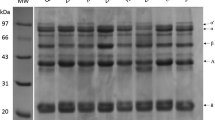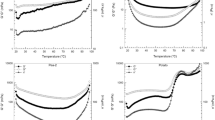Abstract
Soy protein isolate (SPI) gels emulsified with oils including soybean, olive, palm, and eicosapentaenoic acid (EPA) were prepared by a microbial transglutaminase (MTGase). The hardness of 10% SPI gel was greatly increased by adding higher amount of oils. The emulsion gels prepared with 10% SPI and 30% olive oil showed the highest hardness of 1,711 g. In the gelation with various oil content (5–30%), the higher concentration of oils indicated the drastic increase of elastic modulus G′ and viscous modulus G″ during initial gelation for 7 min. The G′ value of SPI emulsion gel showed the 150 (soybean oil 30%), 147 (olive oil 30%), 121 (palm oil 30%), and 61 Pa (EPA 25%), respectively. In the color value of SPI emulsion gel, addition of higher concentration of oils resulted in the increase of L value (brightness), indicating 99.14 (L value) at 30% palm oil. The micro-structure of SPI emulsion gel entrapped with various oils showed the homogeneous network with small porosity compared with that of SPI gel without oil. In particular, SPI emulsion gel with 10% palm oil showed the compact structure distributed evenly with small porosity. Conclusively, the functional and rheological properties of SPI emulsion gel produced by catalytic action of MTGase could be modulated by the type and content of oils fortified.
Similar content being viewed by others
References
Krog NJ, Spars FV. Food emulsifiers: Their chemical and physical properties. pp. 45–91. In: Food Emulsions. Friberg SE, Larsson K, Sjöblom J (eds). Marcel Dekker, New York, NY, USA (2004)
Rodriguez Patino JM, Rodriguez Niño MR, Carrera Sánchez C, Navarro Garcia JM, Rodriguez Mateo GR, Cejudo Fernández M. The effect of temperature on food emulsifiers at fluid-fluid interface. Colloid. Surface. B 21: 87–99 (2001)
Surh J, Decker EA, McClements DJ. Properties and stability of oilin water emulsions stabilized by fish gelatin. Food Hydrocolloid. 20: 596–606 (2006)
Moure A, Sineiro J, Dominguez H, Parajó JC. Functionality of oilseed protein products: A review. Food Res. Int. 39: 945–963 (2006)
Puski G. Modification of functional properties of soy proteins by proteolytic enzyme treatment. Cereal Chem. 52: 655–664 (1975)
Wolf WJ. Functionality of vegetable proteins other than soy. J. Am. Oil Chem. Soc. 56: 280–284 (1979)
Yasumatsu K, Sawada S, Monaka S, Misaki M, Toda J, Wada T, Ishil K. Whipping and emulsifying properties of soybean products. Agr. Biol. Chem. Tokyo 36: 719–728 (1972)
Gu X, Campbell LJ, Euston SR. Effects of different oils on the properties of soy protein isolate emulsions and gels. Food Res. Int. 42: 925–932 (2009)
Kim KH, Renkema MS, Vliet TV. Rheological properties of soybean protein isolate gels containing emulsion droplets. Food Hydrocolloid. 15: 295–302 (2001)
Ikura K, Yoshikawa MY, Sasaki R, Chiba H. Incorporation of amino acids into food proteins by transglutaminase. Agr. Biol. Chem. Tokyo 45: 2587–2592 (1981)
Santos M, Torne JM. Recent patents on transglutaminase production and applications: A brief review. Recent Pat. Biotechnol. 3: 166–174 (2009)
Ando H, Adachi M, Umeda K, Matsuura A, Nonaka M, Uchio R, Tanaka H, Motoki M. Purification and characteristics of a novel transglutaminase derived from microorganisms. Agr. Biol. Chem. Tokyo 53: 2613–2617 (1989)
Faergemand M, Otte J, Qvist KB. Enzymatic cross-linking of whey protein by a Ca2+ independent microbial transglutaminase from Streptomyces lydicus. Food Hydrocolloid.11: 19–25 (1997)
Motoki M, Kumazawa Y. Recent research trends in transglutaminase technology for food processing. Food Sci. Technol. Res. 6: 151–160 (2000)
Joo SI, Kim JE, Lee SP. Physicochemical properties of whole soybean curd prepared by microbial transglutaminase. Food Sci. Biotechnol. 20: 437–444 (2011)
Lee DS. Improvement of emulsion stability of food proteins by microbial transglutaminase. Korean J. Food Sci. Technol. 37: 164–170 (2005)
Herrero AM, Carmona P, Pintado T, Jimenez-Colmenero F, Ruiz-Capilas C. Infrared spectroscopic analysis of structural features and interactions in olive oil-in-water emulsions stabilized with soy protein. Food Res. Int. 44: 360–366 (2011)
Dyerberg J, Bang HO, Stohersen E. Eicosapentaenoic acid and prevention of thrombosis and atherosclerosis. Lancet 2: 117–121 (1978)
Bang HO, Dyerberg J, Sinclair HM. The composition of the Eskimo food in north western Greenland. Am. J. Clin. Nutr. 33: 2657–2661 (1980)
Cho SY, Miyashita K, Miyawa T, Fusimoto K, Kaneta T. Autoxidation of ethyl eicosapentaenoate and docosahexaenoate. J. Am. Oil Chem. Soc. 64: 876–879 (1987)
Arboleya JC, Ridout MJ, Wilde PJ. Rheological behavior of aerated palm kernel oil/water emulsions. Food Hydrocolloid. 23: 1358–1365 (2009)
Lee HA, Choi SJ, Moon TW. Characteristics of sodium caseinate and soy protein isolate-stabilized emulsion-gels formed by microbial transglutaminase. J. Food. Sci. 71: 352–357 (2006)
Clare DA, Daubert CR. Expanded functionality of modified whey protein dispersions after transglutaminase. J. Food. Sci. 76: 576–584 (2011)
Kim KH, Renkema MS, Vliet TV. Rheological properties of soybean protein isolate gels containing emulsion droplets. Food Hydrocolloid. 15: 295–302 (2001)
Liu C, Wang X, Ma H, Zhang Z, Gao W, Xiao L. Functional properties of protein isolates from soybeans stored under various conditions.. Food Chem. 111: 29–37 (2008)
Tang CH, Zhong C, Lin L, Xiao QY. Effects of transglutaminase treatment on the thermal properties of soy protein isolates. Food Res. Int. 39: 704–711 (2006)
Byun SM, Kim CJ. Functional properties of soy protein isolates prepared from defatted soybean meal. Korean J. Food Sci. Technol. 9: 123–130 (1977)
Xin G, Lydia J, Stephen RE. Effects of different oils on the properties of soy protein isolate emulsions and gels. Food Res. Int. 42: 925–932 (2009)
Dickinson E, Yamamoto Y. Rheology of milk protein gels and protein-stabilized emulsion gels cross-linked with transglutaminase. J. Agr. Food Chem. 44: 1371–1377 (1996)
Author information
Authors and Affiliations
Corresponding author
Rights and permissions
About this article
Cite this article
Jin, IH., Kim, JE., Seo, JH. et al. Physicochemical properties of soy protein isolate gels emulsified with various oils using a microbial transglutaminase. Food Sci Biotechnol 22 (Suppl 1), 129–136 (2013). https://doi.org/10.1007/s10068-013-0058-0
Received:
Revised:
Accepted:
Published:
Issue Date:
DOI: https://doi.org/10.1007/s10068-013-0058-0




